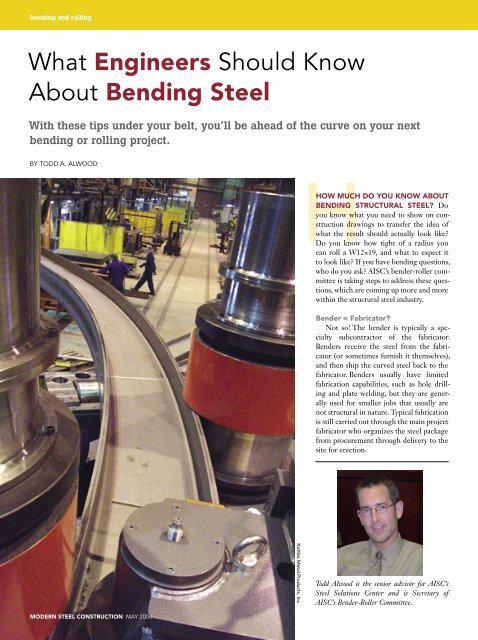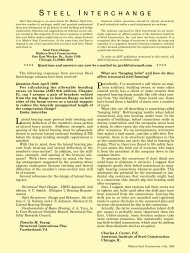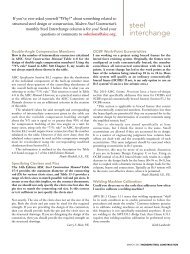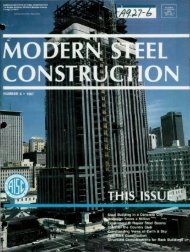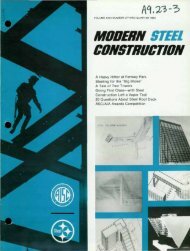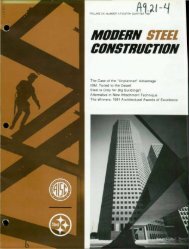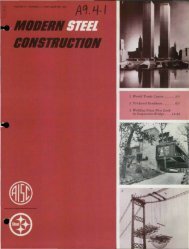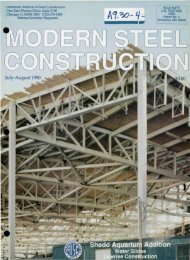What Engineers Should Know About Bending Steel - Modern Steel ...
What Engineers Should Know About Bending Steel - Modern Steel ...
What Engineers Should Know About Bending Steel - Modern Steel ...
You also want an ePaper? Increase the reach of your titles
YUMPU automatically turns print PDFs into web optimized ePapers that Google loves.
ending and rolling<br />
<strong>What</strong> <strong>Engineers</strong> <strong>Should</strong> <strong>Know</strong><br />
<strong>About</strong> <strong>Bending</strong> <strong>Steel</strong><br />
With these tips under your belt, you’ll be ahead of the curve on your next<br />
bending or rolling project.<br />
BY TODD A. ALWOOD<br />
MODERN STEEL CONSTRUCTION MAY 2006<br />
Kottler Metal Products, Inc.<br />
HOW MUCH DO YOU KNOW ABOUT<br />
BENDING STRUCTURAL STEEL? Do<br />
you know what you need to show on construction<br />
drawings to transfer the idea of<br />
what the result should actually look like?<br />
Do you know how tight of a radius you<br />
can roll a W12×19, and what to expect it<br />
to look like? If you have bending questions,<br />
who do you ask? AISC’s bender-roller committee<br />
is taking steps to address these questions,<br />
which are coming up more and more<br />
within the structural steel industry.<br />
Bender = Fabricator?<br />
Not so! The bender is typically a specialty<br />
subcontractor of the fabricator.<br />
Benders receive the steel from the fabricator<br />
(or sometimes furnish it themselves),<br />
and then ship the curved steel back to the<br />
fabricator. Benders usually have limited<br />
fabrication capabilities, such as hole drilling<br />
and plate welding, but they are generally<br />
used for smaller jobs that usually are<br />
not structural in nature. Typical fabrication<br />
is still carried out through the main project<br />
fabricator who organizes the steel package<br />
from procurement through delivery to the<br />
site for erection.<br />
Todd Alwood is the senior advisor for AISC’s<br />
<strong>Steel</strong> Solutions Center and is Secretary of<br />
AISC’s Bender-Roller Committee.
There’s only one type of bending, right?<br />
Nope! There are five typical methods of bending in the industry: rolling,<br />
incremental bending, hot bending, rotary-draw bending, and induction<br />
bending. Each method has its advantages. Some methods are more<br />
commonly used in the steel construction industry, while others are more<br />
common in the automobile or manufacturing industries:<br />
➜ Rolling (cold bending) is the typical method of curving steel for construction<br />
and is usually the most economical for rolling members with<br />
tighter radii. A steel member is placed in a machine and curved between<br />
three rolls. Cold bending may also be called “pyramid rolling”<br />
because of the three rolls’ pyramid arrangement. <strong>Bending</strong> occurs when<br />
the distance between these rolls is manipulated before each successive<br />
pass.<br />
➜ Incremental bending or gag pressing is usually used for cambering<br />
and curving to very large radii. <strong>Bending</strong> is achieved by applying point<br />
loads with a hydraulic ram or press at the member’s third point.<br />
➜ Hot bending is where a structural member is heated directly and then<br />
bent. The heat source could be a direct flame or furnace. This application<br />
is used extensively in repair.<br />
➜ Rotary-draw bending is where the structural member is bent by rotating<br />
it around a die. The member is clamped into a form and then<br />
is drawn through the machine until the bend is formed. This method<br />
produces tight radii and is mainly used for complicated bends in the<br />
machine and parts industry.<br />
➜ Induction bending uses an electric coil to heat a short section of a<br />
structural member, and then that member is drawn through a process<br />
similar to rotary-draw and cooled with water directly after. In some<br />
cases, this process can produce a smaller, tighter radius.<br />
<strong>What</strong> about construction drawings?<br />
Have you worked on a building project that included bent steel and then<br />
had to answer RFIs because you were not exactly sure what the detailer<br />
or bender needed to produce that curved member? Here are several very<br />
important but very simple items that should be included on construction<br />
drawings when dealing with curved steel.<br />
➜ <strong>What</strong> are you trying to bend—what is the member shape and<br />
size? This is simple and straightforward, but the benders often see<br />
requests for an estimate without a member size, and there is a big difference<br />
between bending a W8×10 and a W40×215. Plus, don’t forget<br />
to list the grade of steel for the member, and if it must be domestically<br />
produced.<br />
➜ How about the orientation of the member? The table at right<br />
shows several different member shapes with common terminologies.<br />
• “Easy way” is bending a member around its weak axis, and “hard way”<br />
Common Terminology and Essential<br />
Dimensions for Curving Common<br />
Hot-Rolled Shapes<br />
MAY 2006 MODERN STEEL CONSTRUCTION
MODERN STEEL CONSTRUCTION MAY 2006<br />
is bending around the strong axis;<br />
• “Flanges in” or “flanges out” refers to<br />
the direction of the flanges on channels,<br />
angles, and tees;<br />
• When an angle is curved on its diagonal,<br />
is the heel (the intersection of<br />
each leg) oriented in, out, or up?<br />
➜ Note whether the section is going to be<br />
used in an AESS (architecturally exposed<br />
structural steel) application—tolerances<br />
will be tighter and more attention will<br />
be paid to possible imperfections or distortions.<br />
Of course, this could increase<br />
the cost of bending, so be sure it’s specified<br />
sparingly—such as when the steel is<br />
within 20’-0” of the viewer’s eye level.<br />
➜ Be sure to label the correct radius. If<br />
you have a W8×10 bent the hard way<br />
and you need the inside radius to be 10’,<br />
then label that on the drawings.<br />
➜ A final item to note is the trimming<br />
requirement. If you have a 25’ length of<br />
beam, only 22’ to 23’ of that beam may be<br />
bent due to the placement requirements<br />
within the bending machine. Note the<br />
total length of beam needed on the<br />
drawings for the estimator, material<br />
purchaser, and detailer. The last thing<br />
you want to hear from the field is that<br />
the beam is short.<br />
Ask the Experts<br />
<strong>What</strong> if you have a spiral channel<br />
stringer for a staircase that needs to be bent<br />
in both directions? How do you go about<br />
detailing that properly? <strong>What</strong> about that<br />
thin-walled HSS tube? Can it be bent to a<br />
16’ radius without buckling the walls?<br />
Contact an AISC member bender-roller<br />
with specific questions like these. AISC<br />
member bender-rollers can lend their expertise<br />
and work through a solution with<br />
you. Realize that your client is coming to<br />
you because you are an expert in engineering<br />
or architecture—so go to an expert in<br />
bending.<br />
For a list of AISC member bender-rollers,<br />
please visit www.aisc.org/benders or<br />
see pages 63-66 in this month’s issue. And,<br />
as always, AISC’s <strong>Steel</strong> Solutions Center<br />
is available to answer any and all questions<br />
concerning structural steel within<br />
one business day. Contact the <strong>Steel</strong> Solutions<br />
Center at 866.ASK.AISC or at<br />
solutions@aisc.org.


